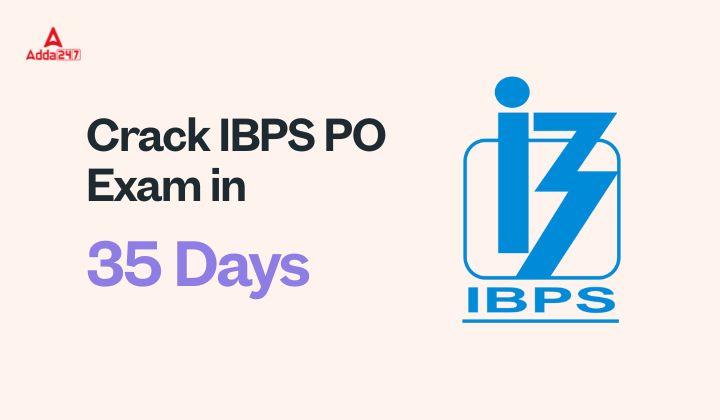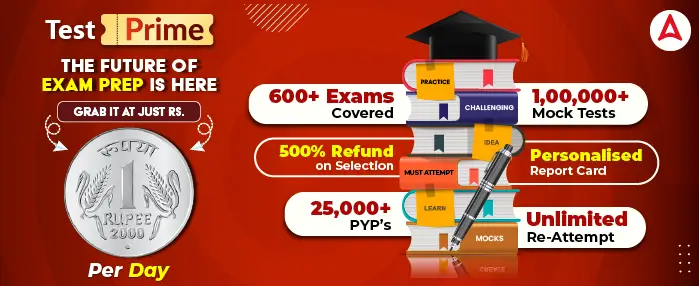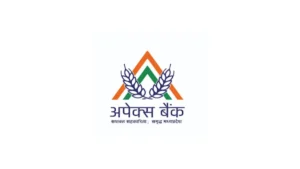The IBPS PO exam is among the most sought-after banking exams in India, drawing thousands of aspirants each year. With just 35 days in hand, cracking the Prelims requires a well-structured study plan, efficient time management, and a solid grasp of the latest exam pattern and syllabus. This 35-day preparation guide is designed to help you stay focused, practice smartly, and boost your chances of clearing the Prelims and stepping closer to becoming a Probationary Officer.
Crack IBPS PO Exam in 35 Days
As you all know, it is clearly mentioned in the IBPS PO Notification 2025 that the exam pattern has witnessed a major change. One of the most noticeable changes is the increased importance given to the Reasoning section, which now holds a greater weightage compared to previous years. As the weightage of the Reasoning section has increased, candidates should give it special attention to improve their overall score.
Check Out the Latest Detailed Exam Pattern
The IBPS PO Preliminary Exam 2025 features three objective sections: English Language, Quantitative Aptitude, and Reasoning Ability. The exam comprises a total of 100 questions carrying 100 marks, with each section allotted 20 minutes, making the overall duration 60 minutes. According to the latest exam pattern, the Reasoning Ability section now holds the highest weightage with 40 marks, while the Quantitative Aptitude section has been reduced to 30 marks. The English Language section remains unchanged at 30 marks.
Attempt a Previous Year Paper to Gauge the Difficulty
Before starting your full-fledged preparation, it is highly recommended to attempt at least one previous year paper (PYP) under real exam conditions. This practice will give you a clear understanding of the actual difficulty level and the time pressure experienced during the exam. It will also help you identify your strengths and weaknesses, along with highlighting the topics that are frequently repeated. Make sure to note down the areas where you struggled and prioritize them in your study plan for focused improvement.
Build Strong Fundamentals of All Subjects
In the 35-day crash course for IBPS PO, building a strong foundation is essential to make the most of your limited time. With just five weeks to prepare, focus the first 10–12 days on understanding basic concepts across all three sections English Language, Quantitative Aptitude, and Reasoning Ability. Spend the next 15–18 days on focused practice and sectional tests to improve speed and accuracy. In the final 5–7 days, shift your focus to full-length mock tests and revision.
Quantitative Aptitude – Strengthen Speed & Accuracy
Quant is a high-scoring yet time-consuming section. Building fundamentals here means mastering concepts and developing speed with short tricks and logical approaches.
Speed Maths: Learn tables up to 30, squares up to 50, cubes up to 20, and percentage-to-fraction conversions (e.g., 33.33% = 1/3). These are essential for faster calculation in DI and arithmetic.
Percentages & Ratios: These are the base for Profit & Loss, SI/CI, Time & Work, and DI questions. Understand how to use percentages quickly in comparison, increase/decrease, and net effect problems.
Simplification & Approximation: Practice BODMAS, square roots, cube roots, and basic approximations using Vedic math tricks. These help in saving time and improving accuracy in Prelims.
Data Interpretation (DI): Start with basic tabular and bar graph DI sets. Focus on interpretation skills reading data quickly and applying average, percentage, and ratio-based calculations without errors.
Basic Arithmetic Topics: Work on foundational chapters like Time & Work, Time & Distance, Mixtures, Averages, and Simple Interest. Use examples and short formulas for better grasp.
Reasoning Ability – Build Logical Thinking First
Reasoning tests your ability to solve problems quickly and accurately. Before diving into tricky puzzles, make sure your logical fundamentals are solid.
Puzzle and Seating Arrangement: Firstly understand common terms like left/right, just above/below, immediate neighbors etc. and identify the key conditions, breaking down the clues step by step and eliminating possible scenarios. Start with definite placements, fill in the gaps, and maintain clarity to solve efficiently under time pressure.
Syllogism: Learn traditional as well as Venn diagrams based approaches to visualize the logic and eliminate incorrect options. Focus on the ‘All’, ‘Some’, and ‘No’ relationships to draw clear conclusions and understand the relationships between the statements.
Inequality: First identify the symbols used (>, <, ≥, ≤, =, or ≠). Simplify the given statements step-by-step and establish the correct relationship between elements. Use the direct method for simple inequalities, and for compound inequalities, break them into parts to analyze systematically. Eliminate options based on the established relationships for quick and accurate answers.
Blood Relation: Pay attention to keywords like ‘father’, ‘mother’, ‘sister’, ‘brother’, cousin, etc.,. First decode the relationships mentioned in the statements by drawing a family tree or diagram to visualize the connections. Start by identifying the direct relationships and use elimination techniques for indirect ones.
Direction: To solve direction and distance questions, start by visualizing the movements on a diagram or grid. Break down each instruction step-by-step, considering the cardinal directions (North, South, East, West) and their combinations (e.g., North-East). Pay attention to the total distance and direction at each step, and keep track of the final position.
Coding: Understand the words and codes systematically. Look for consistent words and codes in each statement. Write them down one by one and recognize the patterns.
Other Miscellaneous topics: Miscellaneous topics like word-based, number-based, and series questions are all about spotting the hidden patterns. With a calm approach and a sharp mind, you can break these down easily. Take your time to understand the relationship, and soon enough, you’ll be solving them with confidence and speed.
English Language – Focus on Core Grammar & Comprehension
Many candidates struggle with English due to lack of grammar clarity or limited vocabulary. But with the right basics, you can make this your scoring section.
Grammar Rules: Brush up on tenses, subject-verb agreement, articles, prepositions, and modifiers. Use resources like Wren & Martin or trusted online grammar modules.
Vocabulary: Learn 5–10 new words daily, including their meanings, synonyms, antonyms, and usage. Focus on words frequently asked in banking exams.
Reading Comprehension (RC): Start reading editorial articles from The Hindu or Indian Express. Practice RC sets to improve inference-based understanding and reduce reading time.
Cloze Test & Sentence Completion: Understand the context of the passage and improve your grammar and word choice. Focus on sentence flow and word tone.
Error Spotting & Sentence Improvement: Practice sentence correction based on grammar and structure. Learn how to spot awkward or ungrammatical phrases.
Practice Previous Year Papers (PYPs) Regularly
Solving Previous Year Papers (PYPs) is one of the most effective ways to boost your preparation. These papers not only help you understand the actual exam difficulty and question patterns, but also train you to manage time efficiently in the real exam environment.
Attempt PYPs Strategically Over 35 Days: Plan to solve at least 3-5 PYPs per week, gradually increasing the frequency as your preparation progresses. Use a real exam setup with a timer and avoid distractions to simulate the actual test experience. This will help improve your speed, accuracy, and question selection skills.
Create a 35-Day Smart Study Plan
A well-structured and time-bound study plan is crucial to track your daily progress and stay exam-ready. In these 35 days, you must balance concept-building, regular practice, and smart revision. Here’s how you can systematically approach your preparation.
Days 1 to 10: Build Your Foundation
Focus on building a strong base in all three Prelims subjects: Quantitative Aptitude, Reasoning Ability, and English Language. During this phase, cover fundamental concepts and practice questions topic by topic. Allocate dedicated time each day to work on formulas, grammar rules, and puzzle techniques. Alongside theory, start attempting one sectional mock every three days to test your conceptual understanding and improve time management.
Days 11 to 22: Practice, Analyze, and Upgrade
Once you are comfortable with the basics, shift to mixed practice across topics. This phase should focus on improving your speed and precision. Start solving Mains-level questions, particularly Data Interpretation, High-Level Puzzles, and Advanced RCs. Begin attempting one full-length mock test every two days and dedicate ample time to analyzing your mistakes and revising weak areas. Keep refining your approach and focus more on question selection and time allocation.
Days 23 to 30: Simulate the Real Exam
Boost your preparation with full-length prelims mocks every other day to simulate real exam conditions. Evaluate your performance with every test, and identify patterns in mistakes. This is also the best time to start descriptive writing practice learn the proper format for essay and letter writing. Don’t forget to revise General Awareness and Banking Awareness daily, including current affairs, RBI updates and financial news highlights of the last 3-4 months.
Days 31 to 35: Final Touch and Confidence Boost
Use these last five days for intense revision and mock analysis. Go through your error logs, mock summaries, short notes, and unattempted questions. Focus more on consolidating what you have learned rather than starting anything new. Attempt 3-5 full-length mocks in this period to maintain exam rhythm. Most importantly, stay calm, positive, and confident trust your preparation and keep your mind clear for the exam day.
Take Regular Mock Tests
Mock tests help you simulate real exam pressure and improve time management. Start with sectional tests, then move to full-length mocks. Use trusted platforms like Adda247 with Test Prime that follow the latest IBPS PO pattern. Stick to a routine start with 3–5 mocks/week and gradually increase.
Crack IBPS PO Exam By This Plan
| Related Post | |
| IBPS PO Exam Date 2025 | IBPS PO Salary |
| IBPS PO Previous Year Papers | IBPS PO Syllabus |
| IBPS PO Mock Test | IBPS PO Eligibility |




 MP Apex Bank Syllabus 2026 and Exam Patt...
MP Apex Bank Syllabus 2026 and Exam Patt...
 MP Apex Bank Recruitment 2026 Notificati...
MP Apex Bank Recruitment 2026 Notificati...
 RBI Grade B 2026 Notification, Exam Date...
RBI Grade B 2026 Notification, Exam Date...







